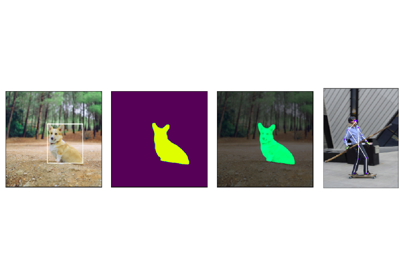keypointrcnn_resnet50_fpn
-
torchvision.models.detection.keypointrcnn_resnet50_fpn(pretrained=False, progress=True, num_classes=2, num_keypoints=17, pretrained_backbone=True, trainable_backbone_layers=None, **kwargs)[source] Constructs a Keypoint R-CNN model with a ResNet-50-FPN backbone.
Reference: “Mask R-CNN”.
The input to the model is expected to be a list of tensors, each of shape
[C, H, W], one for each image, and should be in0-1range. Different images can have different sizes.The behavior of the model changes depending if it is in training or evaluation mode.
During training, the model expects both the input tensors, as well as a targets (list of dictionary), containing:
boxes (
FloatTensor[N, 4]): the ground-truth boxes in[x1, y1, x2, y2]format, with0 <= x1 < x2 <= Wand0 <= y1 < y2 <= H.labels (
Int64Tensor[N]): the class label for each ground-truth boxkeypoints (
FloatTensor[N, K, 3]): theKkeypoints location for each of theNinstances, in the format[x, y, visibility], wherevisibility=0means that the keypoint is not visible.
The model returns a
Dict[Tensor]during training, containing the classification and regression losses for both the RPN and the R-CNN, and the keypoint loss.During inference, the model requires only the input tensors, and returns the post-processed predictions as a
List[Dict[Tensor]], one for each input image. The fields of theDictare as follows, whereNis the number of detected instances:boxes (
FloatTensor[N, 4]): the predicted boxes in[x1, y1, x2, y2]format, with0 <= x1 < x2 <= Wand0 <= y1 < y2 <= H.labels (
Int64Tensor[N]): the predicted labels for each instancescores (
Tensor[N]): the scores or each instancekeypoints (
FloatTensor[N, K, 3]): the locations of the predicted keypoints, in[x, y, v]format.
For more details on the output, you may refer to Instance segmentation models.
Keypoint R-CNN is exportable to ONNX for a fixed batch size with inputs images of fixed size.
Example:
>>> model = torchvision.models.detection.keypointrcnn_resnet50_fpn(pretrained=True) >>> model.eval() >>> x = [torch.rand(3, 300, 400), torch.rand(3, 500, 400)] >>> predictions = model(x) >>> >>> # optionally, if you want to export the model to ONNX: >>> torch.onnx.export(model, x, "keypoint_rcnn.onnx", opset_version = 11)
- Parameters
pretrained (bool) – If True, returns a model pre-trained on COCO train2017
progress (bool) – If True, displays a progress bar of the download to stderr
num_classes (int) – number of output classes of the model (including the background)
num_keypoints (int) – number of keypoints, default 17
pretrained_backbone (bool) – If True, returns a model with backbone pre-trained on Imagenet
trainable_backbone_layers (int) – number of trainable (not frozen) resnet layers starting from final block. Valid values are between 0 and 5, with 5 meaning all backbone layers are trainable. If
Noneis passed (the default) this value is set to 3.
Examples using
keypointrcnn_resnet50_fpn:

